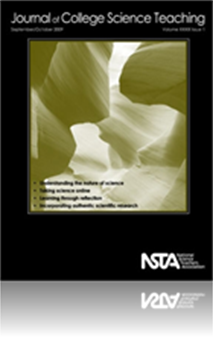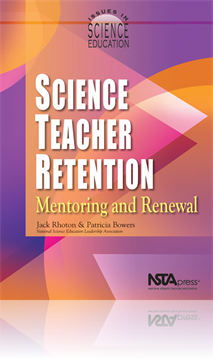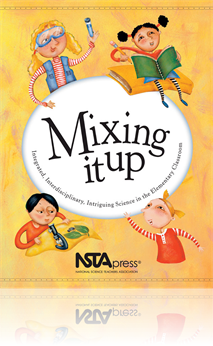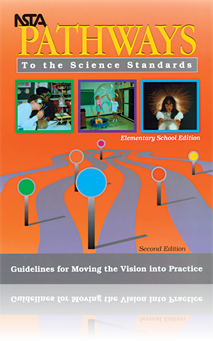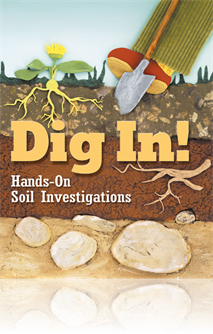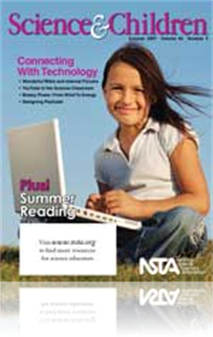All Resources
Journal Article
A 3–D virtual field trip was integrated into an online college entomology course and developed as a trial for the possible incorporation of future virtual environments to supplement online higher education laboratories. This article provides an exp...
eBook
Science Teacher Retention: Mentoring and Renewal (e-book)
“Some forty percent of all new science teachers leave the profession within five years, and too many science teachers are wedded to their textbooks and the routines they acquired during their collegiate years." What can be done to retain new scienc...
eBook
Teaching Science in the Two-Year College: An NSTA Press Journals Collection (e-book)
Two-year colleges are critical to science education’s future—in fact, some data indicate that half of future science teachers will take their first years of science at a two-year school. To address the unique challenges of this special setting, T...
eBook
This must-have tool for applying the Standards in real classrooms has been fully revised for 21st century high schools. Of course, the best parts haven’t changed! Our top-selling practical guide still demonstrates how you can bring to life the visi...
eBook
The NSTA Ready-Reference Guide to Safer Science, Volume 1 (e-book)
As a science educator, you know the importance of using best safety practices to protect your students physically during hands-on science instruction. But do you also know how to protect yourself legally even in aging facilities and crowded labs? Lea...
eBook
Mixing It Up: Integrated, Interdisciplinary, Intriguing Science in the Elementary Classroom (e-book)
This book—a compilation of 25 practical articles from NSTA’s elementary school journal, Science & Children—offers a wealth of lesson plans and idea starters using interdisciplinary, integrated, and thematic approaches. Discover how a language a...
eBook
Your job: taking lofty educational goals and achieving them in the real world. Your best source of help: The Pathways books--one for elementary, middle, and high school--are brimming with practical guidance for putting the Standards into action. Pack...
eBook
Throughout the pages of NSTA Pathways to the Science Standards: Guidelines for Moving the Vision into Practice, we demonstrate how you can bring the "vision" of the National Science Education Standards into the middle school curriculum. It enco...
eBook
Science Educator's Guide to Laboratory Assessment (e-book)
Focus on frequent, accurate feedback with this newly expanded guide to understanding assessment. Field-tested and classroom ready, it's designed to help you reinforce productive learning habits while gauging your lessons' effectiveness. The book open...
eBook
Dig In! Hands-On Soil Investigations (e-book)
Give students the dirt on soil with a practical book that brings new meaning to the term "hands-on." Using these 12 activities and two original stories as guides, kids will soon be up to their elbows in the study of soil formation, habitats and land ...
eBook
Science Fairs Plus: Reinventing an Old Favorite, Grades K-8 (e-book)
At last: a sure cure for science fair fatigue. This new book -- a collection of 20 articles from NSTA's member journals for elementary, middle, and high school teachers -- is bound to re-energize the way you plan and produce these mainstay events. ...
eBook
Start Young! Early Childhood Science Activities (e-book)
You asked for it—now you’ve got it! In a focus group at a recent NSTA convention, teachers of prekindergarten through second grade clamored for help. They do want easy-to-do science activities they can use for everyday teaching. But they don’t ...
eBook
Stepping Up to Science and Math: Exploring the Natural Connections (e-book)
Stepping Up to Science and Math invites you to step back and rethink the way you teach both of these essential subjects. Then it illustrates how you can step up the pace with Standards-based activities that make learning more effective and efficient....
eBook
Garden Genetics: Teaching With Edible Plants (Teacher Edition) (e-book)
Tired of teaching genetic concepts with the same old pink petunias and Mendel’s peas? With Garden Genetics, you can present core content in ways that are fun for students and fresh for you. ...
eBook
The Life Cycle of Everyday Stuff (e-book)
Your students need to understand that stuff doesn’t just happen—it has a life cycle. Using common products like the telephone, this lively book helps students learn about the flow of energy and matter through Earth’s system. Seven illustrated s...
Journal Article
Editor’s Roundtable: Classroom management à la Goldilocks
Classroom management is a difficult balancing act. Like Goldilocks, teachers should sample all the classroom management techniques available to them to find the ones that are “just right” for their classroom. Therefore, teachers must quickly esta...
Journal Article
Science Shorts: Larger Than Life—Introducing Magnifiers
Even simple technologies can provide important support for the inquiry process. Hand lenses and other magnifiers are ubiquitous technologies in the science classroom. In the following activity, children learn how to use a simple hand lens. They draw ...
eBook
Evolution in Perspective: The Science Teacher's Compendium (e-book)
If ever a subject could benefit from a strong dose of perspective, it’s evolution. This important new book supplies the necessary insights by bringing together the views of leading scientists, professors, and teachers. Working from the premise that...
Journal Article
Perspectives: Finding a Place for Girls in Science
Because teacher expectations and classroom interactions often favor boys in science, teachers need to consider strategies to create gender-inclusive science classrooms, as suggested by researchers Brotman and Moore (2008) and Jones, Howe, and Rua (20...
Journal Article
Society for College Science Teachers: Wearing Too Many Hats
How do you determine if an incoming freshman is ready for your class? How much responsibility do we bear in helping students make this critical transition? Do students today really process information differently than we did? How well do remedial cou...
Journal Article
Ready to kick off your shoes and make tracks toward vacation? Whether you run to the nearest beach, or just prop your feet up and relax, there’s no better path to renewal than one that runs through the pages of a good book. Again this year, the tea...
Journal Article
Guest Editorial: Elementary Science Education in the K–12 System
Elementary science is a critical part of the K–12 science education system. Tragically, the enactment of No Child Left Behind (NCLB) has greatly diminished the time spent on teaching science in many elementary schools. In some schools that have not...
Journal Article
Hypotheses of population genetics are derived and tested by students in the introductory genetics laboratory classroom as they explore the effects of biotic variables (physical traits of fruit flies) and abiotic variables (island size and distance) o...
Journal Article
Research and Teaching: Student Learning in a Project-Based Molecular Biology Course
Inquiry-based learning was used to enhance an undergraduate molecular biology course. The goal was to use a long-term, in-class project in a studio class setting to enable students to acquire the knowledge and confidence to problem solve. Mixed-metho...
Journal Article
Science 101: How do windmills generate power?
This is a timely question given that you can now buy your own windmill (or more correctly, wind turbine) for residential use. More on that later. Using windmills to generate electricity makes sense once you understand how we generate electricity. So ...



